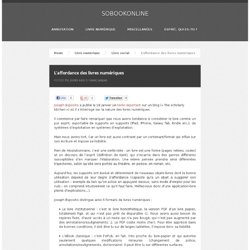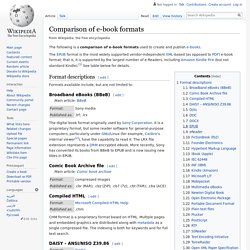

L'affordance des livres numériques. Joseph Esposito a publié le 18 janvier un texte important sur un blog (« The scholarly kitchen ») où il s’interroge sur la nature des livres numériques.

Il commence par faire remarquer que nous avons tendance à considérer le livre comme un pur esprit, exportable de supports en supports (iPad, iPhone, Galaxy Tab, Kindle etc.), de systèmes d’exploitation en systèmes d’exploitation. Mais nous avons tort. Car un livre est aussi contraint par un contenant/format qui influe sur son écriture et impose sa lisibilité. Rien de révolutionnaire, c’est une vieille idée : un livre est une forme (pages reliées, codex) et un discours de l’esprit (définition de Kant), qui s’incarne dans des genres différents susceptibles d’en marquer l’élaboration. Une même pensée prendra ainsi différentes trajectoires, selon qu’elle sera portée au théâtre, en poésie, en roman, etc. Joseph Esposito distingue ainsi 6 formats de livres numériques : Deux remarques : Coming to an e-book near you - LG's flexible e-paper display. Coming to an e-book near you - LG's flexible e-paper display Like most display manufacturers, LG has kept a finger in the flexible e-paper pie.

Now, however, the company has announced that its six-inch XGA resolution Electronic Paper Display (EPD) is now in full production, and should be in devices bound for Europe within the next month. LG's new plastic EPD, claimed to be the world's first in mass production, takes the form of a plastic substrate that is 0.7 millimeters (0.027 in) thick, about 2/3 the thickness of glass EPD devices. At 14 grams (0.49 oz) in weight, the new display comes in at less than half the weight of glass-based alternatives. However, the flexibility is what causes the plastic EPD to step up as a game changer. "With the world's first plastic EPD, LG Display has once again proven its reputation for leadership and innovation with a product we believe will help greatly popularize the E-Book market," said Mr.
Source: LG via Engadget About the Author. Comparison of e-book formats. The following is a comparison of e-book formats used to create and publish e-books.

The EPUB format is the most widely supported vendor-independent XML-based (as opposed to PDF) e-book format; that is, it is supported by the largest number of e-Readers, including Amazon Kindle Fire (but not standard Kindle).[1] See table below for details. Format descriptions[edit] Formats available include, but are not limited to: Broadband eBooks (BBeB)[edit] Comic Book Archive file[edit] Compiled HTML[edit] CHM format is a proprietary format based on HTML. DAISY – ANSI/NISO Z39.86[edit] The Digital Accessible Information SYstem (DAISY) is an XML-based open standard published by the National Information Standards Organization (NISO) and maintained by the DAISY Consortium for people with print disabilities. DAISY is already aligned with the EPUB technical standard, and is expected to fully converge with its forthcoming EPUB3 revision.[3] DjVu[edit] DjVu is a format specialized for storing scanned documents.